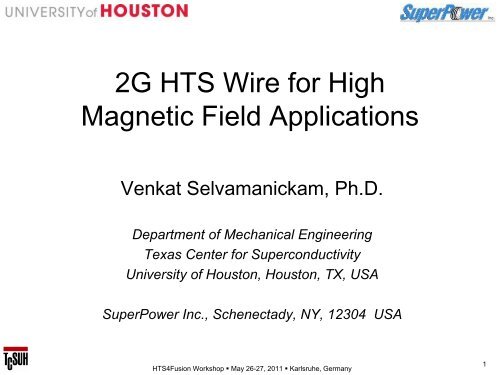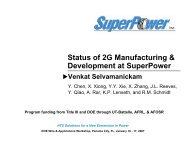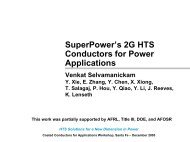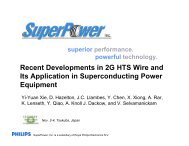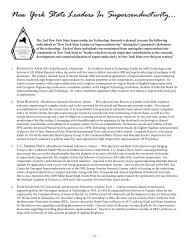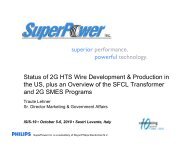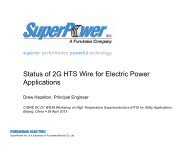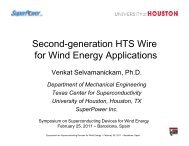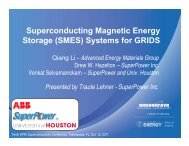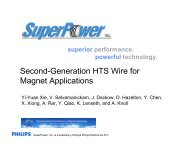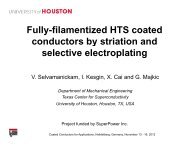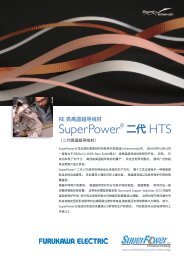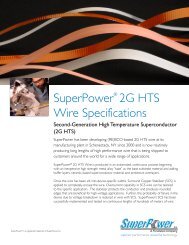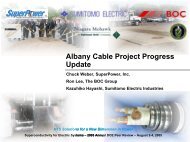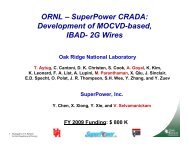2G HTS Wire for High Magnetic Field Applications - SuperPower
2G HTS Wire for High Magnetic Field Applications - SuperPower
2G HTS Wire for High Magnetic Field Applications - SuperPower
Create successful ePaper yourself
Turn your PDF publications into a flip-book with our unique Google optimized e-Paper software.
<strong>2G</strong> <strong>HTS</strong> <strong>Wire</strong> <strong>for</strong> <strong>High</strong><br />
<strong>Magnetic</strong> <strong>Field</strong> <strong>Applications</strong><br />
Venkat Selvamanickam, Ph.D.<br />
Department of Mechanical Engineering<br />
Texas Center <strong>for</strong> Superconductivity<br />
University of Houston, Houston, TX, USA<br />
<strong>SuperPower</strong> Inc., Schenectady, NY, 12304 USA<br />
1<br />
<strong>HTS</strong>4Fusion Workshop • May 26-27, 2011 • Karlsruhe, Germany<br />
1
<strong>2G</strong> <strong>HTS</strong> wire: Great potential <strong>for</strong> applications<br />
• Second-generation (<strong>2G</strong>) high-temperature superconductor (<strong>HTS</strong>) is produced<br />
by thin film vacuum deposition on a flexible nickel alloy substrate in a<br />
continuous reel-to-reel process very different from mechanical de<strong>for</strong>mation &<br />
heat treatment techniques used <strong>for</strong> Nb-Ti, Nb 3<br />
Sn and 1G <strong>HTS</strong> wires<br />
– Only 1% of wire is the superconductor<br />
– ~ 97% is inexpensive Ni alloy and Cu<br />
– Automated, reel-to-reel continuous manufacturing process<br />
– Quality of every single thin film coating can be monitored on-line<br />
in real time !<br />
40 μm Cu total<br />
2 μm Ag<br />
20μm Cu<br />
1 μm YBCO - <strong>HTS</strong> (epitaxial)<br />
100 – 200 nm Buffer<br />
50μm Ni alloy substrate<br />
20μm Cu<br />
<strong>HTS</strong>4Fusion Workshop • May 26-27, 2011 • Karlsruhe, Germany<br />
2
<strong>2G</strong> <strong>HTS</strong> wires provide unique advantages<br />
• <strong>2G</strong> <strong>HTS</strong> wires provide the advantages of high temperature operation at higher<br />
magnetic fields.<br />
• Mechanical properties of <strong>2G</strong> <strong>HTS</strong> wires are also<br />
20μm Cu<br />
superior<br />
YBCO (H//c) YBCO (H//ab) NbTi<br />
Nb3Sn (Internal Sn)<br />
100000<br />
Nb3Sn (Bronze)<br />
< 0.1 mm<br />
50μm Hastelloy<br />
20μm Cu<br />
non-Cu Jc ( A/mm 2 )<br />
10000<br />
1000<br />
100<br />
0 5 10 15 20 25 30 35<br />
Stress (MPa)<br />
800<br />
600<br />
400<br />
<strong>High</strong> Strength<br />
1G <strong>HTS</strong> Low Je<br />
SP <strong>2G</strong> <strong>HTS</strong><br />
<strong>High</strong> Je<br />
Applied <strong>Field</strong> ( Tesla )<br />
200<br />
0<br />
Low Strength<br />
1G <strong>HTS</strong>Moderate Je<br />
Nb3Sn<br />
Moderate Je<br />
0 0.1 0.2 0.3 0.4 0.5<br />
3<br />
<strong>HTS</strong>4Fusion Workshop • May 26-27, 2011 • Karlsruhe, Germany Strain (%)
Advantages of IBAD MgO-MOCVD-based <strong>2G</strong><br />
<strong>HTS</strong> wires<br />
• Use of IBAD MgO as buffer template provides the choice of any substrate<br />
– <strong>High</strong> strength (yield strength > 700 MPa)<br />
– Non-magnetic, high resistive (both important <strong>for</strong> low ac losses)<br />
– Ultra-thin (enables high engineering current density)<br />
– Low cost, off-the-shelf<br />
• <strong>High</strong> deposition rate and large deposition area by MOCVD<br />
– enable high throughput<br />
• Precursors are maintained outside deposition chamber<br />
– Long process runs (already shown 50+ hours)<br />
< 0.1 mm<br />
20μm Cu<br />
2 μm Ag<br />
1 μm YBCO - <strong>HTS</strong> (epitaxial)<br />
~ 30 nm LMO (epitaxial)<br />
~ 30 nm Homo-epi MgO (epitaxial)<br />
YBCO<br />
~ 10 nm IBAD MgO<br />
LaMnO 3<br />
100 nm<br />
50μm Hastelloy substrate<br />
20μm Cu<br />
<strong>HTS</strong>4Fusion Workshop • May 26-27, 2011 • Karlsruhe, Germany<br />
MgO (IBAD + Epi layer)<br />
Y 2 O 3<br />
Al 2 O 3<br />
Hastelloy C-276<br />
4
Successful scale-up of IBAD-MOCVD-based <strong>2G</strong><br />
<strong>HTS</strong> wires<br />
• 500 m <strong>2G</strong> <strong>HTS</strong> wire first<br />
demonstrated in January 2007<br />
(crossed 100,000 A-m)<br />
• 1,000 m <strong>2G</strong> <strong>HTS</strong> wire first<br />
demonstrated in July 2008<br />
(crossed 200,000 A-m)<br />
• Crossed 300,000 A-m in July<br />
2009 with 1,000 m wire.<br />
• 1,400 m lengths are now<br />
routinely produced.<br />
• <strong>High</strong> throughput processing (>><br />
100 m/h* in IBAD & buffer<br />
processes, > 100 m/h* in other<br />
processes)<br />
• Manufacturing capacity of few<br />
hundred km/year<br />
320,000<br />
280,000<br />
240,000<br />
200,000<br />
160,000<br />
120,000<br />
80,000<br />
40,000<br />
0<br />
1 2 3<br />
-0<br />
*4 mm wide equivalent<br />
v l-0<br />
r-0<br />
o u<br />
J<br />
a<br />
N M<br />
<strong>HTS</strong>4Fusion Workshop • May 26-27, 2011 • Karlsruhe, Germany<br />
)<br />
-m<br />
(A<br />
t<br />
h<br />
g<br />
n<br />
e<br />
L<br />
*<br />
t<br />
n<br />
e<br />
r<br />
u<br />
C<br />
l<br />
a<br />
ic<br />
r<br />
it<br />
C<br />
90 A-m to<br />
300,330 A-m<br />
in seven<br />
years<br />
3<br />
-0<br />
v<br />
o<br />
N<br />
4<br />
-0<br />
g<br />
u<br />
A<br />
5<br />
r-0<br />
p<br />
A<br />
595 m<br />
322 m 427 m<br />
1 m 18 m 97 m 206 m<br />
158 m<br />
62 m<br />
5<br />
-0<br />
c<br />
e<br />
D<br />
6<br />
-0<br />
g<br />
u<br />
A<br />
7<br />
r-0<br />
p<br />
A<br />
1,065 m<br />
1,030 m<br />
935 m<br />
790 m<br />
8<br />
-0<br />
n<br />
a<br />
J<br />
8<br />
-0<br />
p<br />
e<br />
S<br />
9<br />
-<br />
0<br />
y<br />
a<br />
M<br />
5
Meeting application requirements <strong>for</strong> <strong>HTS</strong> wire:<br />
Superior per<strong>for</strong>mance in operating conditions<br />
Application<br />
Cables<br />
Wind/Off-shore<br />
Generators<br />
Operating<br />
<strong>Field</strong> (Tesla)<br />
0.01 to 0.1 (ac)<br />
0.1 to 1 (DC)<br />
Operating<br />
Temp. (K)<br />
70 to 77<br />
Key requirements<br />
Low ac losses (ac)<br />
<strong>High</strong> currents (dc)<br />
<strong>Wire</strong> needed per<br />
device (kA-m)<br />
40,000 to<br />
2,500,000<br />
1 to 3 30 to 65 In-field I c 2,000 to 10,000<br />
Trans<strong>for</strong>mers 0.1 65 to 77 Low ac losses 2,000 to 3,000<br />
Fault current<br />
limiters<br />
0.1 65 to 77<br />
Thermal recovery<br />
<strong>High</strong> volts/cm<br />
500 to 10,000<br />
SMES 2 to 30 T 4 to 50 In-field I c 2,000 to 3,000<br />
Automotive<br />
motors<br />
2 to 5 30 to 65<br />
Aerospace 2 to 5 30 to 50<br />
Low ac losses<br />
In-field I c<br />
500 to 1,000<br />
Light weight<br />
In-field I c<br />
1,000 to 2,000<br />
Magnets/coils 5 to 30 4.2 to 40 In-field I c 200 to 2,000<br />
MRI, NMR, HEP,<br />
Fusion reactors<br />
5 to 30 4.2 K to 30<br />
In-field I c<br />
Long lengths<br />
Persistent joints<br />
<strong>HTS</strong>4Fusion Workshop • May 26-27, 2011 • Karlsruhe, Germany<br />
2000 - 100,000+<br />
6
<strong>SuperPower</strong>-UH <strong>2G</strong> wire development strategy<br />
• <strong>SuperPower</strong>’s technology operations consolidated in Houston which enabled total<br />
focus on manufacturing in Schenectady.<br />
Manufacturing objectives<br />
• <strong>High</strong> yield, high volume<br />
operation<br />
• On-time delivery of highquality<br />
wire<br />
• Incorporate new technology<br />
advancements<br />
Technology objectives<br />
• <strong>High</strong> per<strong>for</strong>mance wires<br />
• <strong>High</strong>ly efficient, lower cost<br />
processes<br />
• Advanced wire architectures<br />
• Successful transition to<br />
manufacturing<br />
Manufacturing<br />
Operations in NY<br />
<strong>SuperPower</strong><br />
Manufacturing at<br />
Schenectady, NY<br />
Customers<br />
<strong>HTS</strong>4Fusion Workshop • May 26-27, 2011 • Karlsruhe, Germany<br />
SP staff @<br />
Houston<br />
Technology<br />
in Houston<br />
National Labs<br />
Best of both worlds : strong and concentrated emphasis on<br />
technology development & manufacturing<br />
UH research<br />
staff<br />
CRADAs<br />
7
Improved pinning by Zr doping of MOCVD <strong>HTS</strong><br />
wires<br />
5 nm sized, few hundred nanometer long BZO nanocolumns with<br />
~ 35 nm spacing created during in situ MOCVD process<br />
<strong>HTS</strong>4Fusion Workshop • May 26-27, 2011 • Karlsruhe, Germany<br />
8
Improved pinning by Zr doping of MOCVD <strong>HTS</strong><br />
wires<br />
• Systematic study of improved pinning by Zr addition in MOCVD films at UH.<br />
• Two-fold improvement in in-field per<strong>for</strong>mance achieved !<br />
Process <strong>for</strong> improved in-field per<strong>for</strong>mance successfully<br />
transferred to manufacturing at <strong>SuperPower</strong><br />
<strong>HTS</strong>4Fusion Workshop • May 26-27, 2011 • Karlsruhe, Germany<br />
9
Benefit of Zr-doped wires realized in coil<br />
per<strong>for</strong>mance<br />
Coil properties With Zr-doped wire With undoped wire<br />
Coil ID 21 mm (clear) 12.7 mm (clear)<br />
Winding ID 28.6 mm 19. 1 mm<br />
# turns 2688 3696<br />
<strong>2G</strong> wire used ~ 480 m ~ 600 m<br />
<strong>Wire</strong> I c 90 to 101 A 120 to 180 A<br />
<strong>Field</strong> generated at 65 K 2.5 T 2.49 T<br />
Same level of high-field coil per<strong>for</strong>mance can be<br />
achieved with Zr-doped wire with less zero-field 77 K<br />
I c , less wire and larger bore<br />
<strong>HTS</strong>4Fusion Workshop • May 26-27, 2011 • Karlsruhe, Germany<br />
10
Large improvements in in-field Ic of<br />
Zr-doped wires at lower temperatures too<br />
100 A/4 mm<br />
All data from<br />
production<br />
wires<br />
100 A/4 mm achieved at 65 K, 3 T in Zr-doped wire compared to 40 K, 3 T in undoped wire<br />
165 A/4 mm achieved at 40 K, 5 T in Zr-doped wire compared to 18 K, 5 T in undoped wire<br />
<strong>HTS</strong>4Fusion Workshop • May 26-27, 2011 • Karlsruhe, Germany<br />
11
Large improvements in in-field Ic of<br />
Zr-doped wires at lower temperatures too<br />
Retention of 65 K<br />
77 K, zero field I c<br />
3 T<br />
40 K<br />
3 T<br />
18 K<br />
3 T<br />
Undoped wire 0.27 1.02 2.13<br />
Doped wire 0.73 1.99 3.50<br />
Retention factor of<br />
doped wire is higher by<br />
2.7 1.9 1.6<br />
77 K zero-field I c<br />
of 2009 undoped wire = 250 A/cm<br />
77 K zero-field I c of new doped wire = 340 A/cm<br />
Retention factor of<br />
doped wire including<br />
higher zero field Ic is<br />
higher by<br />
3.71 2.64 2.23<br />
<strong>HTS</strong>4Fusion Workshop • May 26-27, 2011 • Karlsruhe, Germany<br />
12
Superior per<strong>for</strong>mance in recent Zr-doped<br />
MOCVD production wires in high fields at 4.2K<br />
60<br />
50<br />
40<br />
Production wire<br />
1.1 µm thick <strong>HTS</strong> film<br />
I c<br />
(77 K, 0 T) = 310 A/cm<br />
1000<br />
T=4.2K<br />
Jc, MA/cm 2<br />
30<br />
20<br />
10<br />
0<br />
0 20 40 60 80<br />
T, K<br />
J c<br />
@ 4.2 K (A/4 mm) 2009 2010<br />
10 T, B ⊥ wire 201 310<br />
20 T, B ⊥ wire 118 183<br />
5 T, B || wire 1,219 1,893<br />
10 T, B || wire 1,073 1,769<br />
I c<br />
- 4mm width (A)<br />
100<br />
undoped, B perp. wire<br />
undoped, B || wire<br />
FY'09 Zr-doped, B perp. wire<br />
FY'09 Zr-doped, B || wire<br />
FY'10 Zr-doped, B perp. wire<br />
FY'10 Zr-doped, B || wire<br />
1 10<br />
B (T)<br />
Measurements by V. Braccini, J. Jaroszynski,<br />
A. Xu,& D. Larbalestier, NHMFL, FSU<br />
In-field per<strong>for</strong>mance of Zr-doped production wires<br />
improved by more than 50% in high fields at 4.2 K<br />
improved <strong>HTS</strong>4Fusion by more Workshop than • May 50% 26-27, 2011 in • high Karlsruhe, fields Germany at 4.2 K<br />
13
<strong>High</strong>-<strong>Field</strong> Magnets demonstrated with <strong>2G</strong> <strong>HTS</strong><br />
wire<br />
• Coils fabricated<br />
by <strong>SuperPower</strong><br />
and NHMFL<br />
• Je ~ 300 A/mm 2<br />
• Stress levels<br />
300 – 400 MPa<br />
<strong>HTS</strong>4Fusion Workshop • May 26-27, 2011 • Karlsruhe, Germany<br />
14
<strong>Applications</strong> enabled by high-field per<strong>for</strong>mance:<br />
Superconducting <strong>Magnetic</strong> Energy Storage (SMES)<br />
• Energy storage with greater than 97% efficiency.<br />
• Provides rapid response <strong>for</strong> either charge or discharge – amount of<br />
energy available is independent of discharge rating – charge and<br />
discharge sequence can repeat infinitely without degradation of magnet<br />
• <strong>2G</strong> <strong>HTS</strong>-based SMES being developed by ABB, <strong>SuperPower</strong>, UH and<br />
BNL through $ 5.2M program funded by ARPA-E (GRIDS: Grid-Scale<br />
Rampable Intermittent Dispatchable Storage)<br />
• 20 kW ultra-high field SMES device with capacity of up to 3.4 MJ based<br />
on <strong>HTS</strong> coils operating at magnetic fields of up to 25 T at 4.2K<br />
<strong>HTS</strong>4Fusion Workshop • May 26-27, 2011 • Karlsruhe, Germany<br />
15
Goals <strong>for</strong> further per<strong>for</strong>mance improvements<br />
• Two-fold improvement in in-field per<strong>for</strong>mance achieved with Zr-doped wires<br />
• Further improvement in I c<br />
at B || c : Now 30% retention of 77 K, zero field value at<br />
77 K, 1 T ; Goal is 50%.<br />
• Improvement in minimum I c<br />
controlling factor <strong>for</strong> most coil per<strong>for</strong>mance : Now 15 to<br />
20% retention of 77 K, zero field value at 77 K, 1 T ; Goal is first 30% and then 50%<br />
• Together with a zero-field I c<br />
of 400 A/4 mm at 77 K, self field 200 A/4 mm at<br />
77 K, 1 T in all field orientations.<br />
• Achieve improved per<strong>for</strong>mance levels at lower temperatures too (< 65 K)<br />
Critical current (A/cmwidth)<br />
1000<br />
800<br />
600<br />
400<br />
200<br />
0<br />
0 1 2 3<br />
Thickness (µm)<br />
Goal<br />
Critical current (A/4 mm)<br />
200<br />
100<br />
10<br />
10x<br />
Standard MOCVD‐based <strong>HTS</strong> tape<br />
MOCVD <strong>HTS</strong> w/ self‐assembled nanostructures<br />
Goal<br />
77 K, 1 T c‐axis<br />
0 30 60 90 120 150 180 210 240<br />
Angle between field and c‐axis (°)<br />
<strong>HTS</strong>4Fusion Workshop • May 26-27, 2011 • Karlsruhe, Germany<br />
16
Multiple strategies to enhance in-field<br />
per<strong>for</strong>mance: higher I c , more isotropic<br />
• Superconductor process modification<br />
– Chemical modifications in MOCVD to<br />
modify defect density, orientation and<br />
size.<br />
• Influence of film thickness on in-field<br />
I c<br />
of Zr-doped films<br />
• Influence of rare earth type and content<br />
• Influence of Zr content at fixed<br />
rare-earth type and content<br />
• Influence of other dopants<br />
• Influence of deposition rate<br />
• Buffer surface modification buffer prior to superconductor growth<br />
• Post superconductor processing modification such as post annealing<br />
etc.<br />
<strong>HTS</strong>4Fusion Workshop • May 26-27, 2011 • Karlsruhe, Germany<br />
17
Opportunities with rare-earth modifications:<br />
Influence of Y+Gd content<br />
• 7.5% Zr in all samples<br />
• Y content = Gd content<br />
• Y+Gd content varied<br />
Critical current can be tuned in desired orientation of magnetic field in<br />
application by modifying total rare earth content even with a fixed Zr % !<br />
<strong>HTS</strong>4Fusion Workshop • May 26-27, 2011 • Karlsruhe, Germany<br />
18
Increased nanoscale (Gd,Y) 2 O 3 precipitates<br />
along a-b plane with increased rare earth content<br />
(Gd,Y) = 1.2<br />
(Gd,Y) = 1.3<br />
(Gd,Y) = 1.4<br />
(Gd,Y) = 1.5<br />
<strong>HTS</strong>4Fusion Workshop • May 26-27, 2011 • Karlsruhe, Germany<br />
19
Thicker (Gd,Y)2O3 precipitates along a-b plane<br />
in high (Gd,Y) wires<br />
(Y,Gd)1.2 (Y,Gd)1.3 (Y,Gd)1.4 (Y,Gd)1.5<br />
0.4<br />
1.0 T, 77 K<br />
I c / I c (B=0)<br />
0.3<br />
0.2<br />
0.1<br />
70 75 80 85 90 95 100 105<br />
Angle beteweend field and c‐axis (°)<br />
TEM by Dean Miller, ANL<br />
<strong>HTS</strong>4Fusion Workshop • May 26-27, 2011 • Karlsruhe, Germany<br />
20
In-field per<strong>for</strong>mance of Zr-doped films is<br />
drastically modified by rare earth content<br />
Zr content maintained at 7.5% in all three samples<br />
Y 1.2<br />
c‐axis<br />
(Y,Gd) 1.5<br />
Multiple controls available to modify pinning per<strong>for</strong>mance of <strong>2G</strong> <strong>HTS</strong> wires!<br />
<strong>HTS</strong>4Fusion Workshop • May 26-27, 2011 • Karlsruhe, Germany<br />
20 nm<br />
21
<strong>High</strong>er amperage wires using thicker films<br />
7<br />
6<br />
Jc (MA/cm2)<br />
5<br />
4<br />
3<br />
Goal<br />
2<br />
0 1 2 3<br />
Critical current (A/cmwidth)<br />
1000<br />
800<br />
600<br />
400<br />
200<br />
0<br />
Thickness (µm)<br />
0 1 2 3<br />
Thickness (µm)<br />
Goal<br />
<strong>HTS</strong>4Fusion Workshop • May 26-27, 2011 • Karlsruhe, Germany<br />
• 800 A/cm (= 320 A/4mm) already<br />
demonstrated over 1 m by MOCVD<br />
• 1000 A/cm (= 400 A/4mm) achieved<br />
in 2 µm film in short samples using<br />
microbridge by PLD at LANL.<br />
22
Jc (MA/cm 2 )<br />
<strong>High</strong>er amperage wires using thicker films<br />
8<br />
7<br />
6<br />
5<br />
4<br />
3<br />
2<br />
1<br />
0<br />
SP<br />
M3<br />
-<br />
714<br />
0 0.5 1 1.5 2 2.5 3 3.5<br />
<strong>HTS</strong> film thickness<br />
Research MOCVD<br />
Pilot MOCVD<br />
Increasing Ic<br />
2016 – 1000 A<br />
2014 – 750 A/cm<br />
2012 – 500 A/cm<br />
Critical current (A/cmwidth)<br />
1000<br />
800<br />
600<br />
400<br />
200<br />
<strong>HTS</strong>4Fusion Workshop • May 26-27, 2011 • Karlsruhe, Germany<br />
0<br />
0 1 2 3<br />
Thickness (µm)<br />
Goal<br />
• Address problems with decreasing<br />
current density with thickness<br />
• <strong>High</strong> currents without significantly<br />
increasing film thickness by increasing<br />
current density (Jc)<br />
– Microstructural improvement (texture,<br />
secondary phases, a-axis, porosity)<br />
– Pinning improvement (interfacial &<br />
bulk defects)<br />
• Opportunity to reduce factor of two<br />
difference between pilot and research<br />
MOCVD systems<br />
23<br />
23
Another benefit with thicker films: better in-field<br />
per<strong>for</strong>mance<br />
All samples were of composition<br />
Y 0.6<br />
Gd 0.6<br />
BCO<br />
Improvement in in-field critical current of Zr-doped<br />
wires increases with film thickness<br />
<strong>HTS</strong>4Fusion Workshop • May 26-27, 2011 • Karlsruhe, Germany<br />
24
Can high-field per<strong>for</strong>mance be improved with<br />
higher Zr doping levels?<br />
• Zero-field critical current drops beyond 7.5% Zr addition.<br />
• Sharper drop in T c beyond 10% Zr addition (3 K from 10% to 25%)<br />
• Transition width increases by 0.5 K beyond 15%<br />
<strong>HTS</strong>4Fusion Workshop • May 26-27, 2011 • Karlsruhe, Germany<br />
25
Superconductor quality degradation at high Zr<br />
doping levels<br />
• (Gd,Y)BCO lattice constant increases steadily with increasing Zr<br />
• (Gd,Y)BCO peak intensity maximum at 7.5% Zr and reduces with<br />
increasing Zr<br />
<strong>HTS</strong>4Fusion Workshop • May 26-27, 2011 • Karlsruhe, Germany<br />
26
In-field Per<strong>for</strong>mance at higher Zr doping levels<br />
2009<br />
0.4 µm film, Y 0.65 Gd 0.65 BCO<br />
2010<br />
0.9 µm film, Y 0.6 Gd 0.6 BCO<br />
• Best per<strong>for</strong>mance at B || c with 7.5% Zr.<br />
• I c at B || a-b increases at higher Zr content even with lower zero-field I c<br />
• Opportunities with high Zr doping levels in B || a-b<br />
<strong>HTS</strong>4Fusion Workshop • May 26-27, 2011 • Karlsruhe, Germany<br />
27
New nanowire technologies being developed<br />
to target large pinning enhancements<br />
• Prefabricated nanorods on buffer surface followed by <strong>HTS</strong> epitaxial growth can<br />
allow <strong>for</strong> independent control of size, distribution and orientation of nanorods.<br />
• Three techniques developed <strong>for</strong> prefabricated nanorod growth on LMO on IBAD<br />
tapes.<br />
<strong>HTS</strong>4Fusion Workshop • May 26-27, 2011 • Karlsruhe, Germany<br />
28
Targeted improvements in in-field per<strong>for</strong>mance<br />
of production wires through technology<br />
• 10-fold improvement by combination of higher self-field critical current and<br />
improved retention of in-field per<strong>for</strong>mance through technical innovations.<br />
• Even at 4.2 K, 15 T, <strong>2G</strong> <strong>HTS</strong> wire is comparable now with Nb 3<br />
Sn wire.<br />
Opportunity to improve to be 10X better than Nb 3<br />
Sn !<br />
<strong>HTS</strong>4Fusion Workshop • May 26-27, 2011 • Karlsruhe, Germany<br />
29
Multfilamentary <strong>2G</strong> <strong>HTS</strong> tapes <strong>for</strong> low ac loss<br />
applications<br />
• Filamentization of <strong>2G</strong> <strong>HTS</strong> tapes is desired<br />
<strong>for</strong> low ac loss applications.<br />
• So far, there is no proven technique to<br />
repeatedly create high quality mulfilamentary<br />
<strong>2G</strong> tapes. Also, adds substantial cost.<br />
ac loss (W/m)<br />
2<br />
1<br />
100 Hz<br />
0<br />
0.00 0.01 0.02 0.03 0.04 0.05 0.06<br />
B ac rms<br />
(T)<br />
unstriated<br />
5.1 x<br />
multifilamentary<br />
4 mm<br />
5-filament tape, 4 mm wide<br />
(produced up to 15 m)<br />
32-filament tape, 4 mm wide<br />
(difficult to make even 1 m lengths)<br />
<strong>HTS</strong>4Fusion Workshop • May 26-27, 2011 • Karlsruhe, Germany<br />
30
Goals in multifilamentary <strong>2G</strong> <strong>HTS</strong> wire fabrication<br />
• Maintaining filament integrity uni<strong>for</strong>m over long lengths (no Ic reduction)<br />
• Striated silver and copper stabilizer (minimize coupling losses)<br />
• Minimum reduction in non superconducting volume (narrow gap) and<br />
fine filaments<br />
Ag<br />
<strong>HTS</strong><br />
Substrate<br />
Cu<br />
A fully filamentized <strong>2G</strong> <strong>HTS</strong> wire would need to have 20 – 50 µm of copper<br />
stabilizer striated !<br />
<strong>HTS</strong>4Fusion Workshop • May 26-27, 2011 • Karlsruhe, Germany<br />
31
Approach to make fully-filamentized <strong>2G</strong> <strong>HTS</strong> wire<br />
Cu Ag <strong>HTS</strong><br />
substrate<br />
100 μm<br />
Cu<br />
1 mm<br />
Fully-filamentized <strong>2G</strong> <strong>HTS</strong> wire demonstrated, but still involves etching<br />
X. Zhang and V. Selvamanickam, US 7,627,356<br />
<strong>HTS</strong>4Fusion Workshop • May 26-27, 2011 • Karlsruhe, Germany<br />
32
Etch-free process developed to fabricated<br />
multifilamentary wire with fully striated stabilizers<br />
12-filament wire with 10 µm thick<br />
fully striated copper stabilizer<br />
<strong>HTS</strong>4Fusion Workshop • May 26-27, 2011 • Karlsruhe, Germany<br />
33
Significant ac loss reduction in multifilamentary<br />
wire with fully striated stabilizers<br />
• Critical current of standard<br />
wire = 207 A<br />
• Critical current of 12-<br />
filament wire = 197 A<br />
• Critical current of 12-<br />
filament wire after 10 µm<br />
copper stabilizer = 200 A<br />
AC loss of 12-fiament wire at<br />
60 Hz is 11 times lower than<br />
that of unstriated wire without<br />
copper stabilizer and 13 times<br />
lower with copper stabilizer, at<br />
higher fields<br />
<strong>HTS</strong>4Fusion Workshop • May 26-27, 2011 • Karlsruhe, Germany<br />
34
Significant ac loss reduction in multifilamentary<br />
wire with fully striated stabilizers<br />
• AC loss of 12-fiament wire at 300 Hz is 11 times lower than that of<br />
unstriated wire with and without copper stabilizer<br />
• AC loss of 12-filament wire unchanged with copper stabilizer unlike<br />
standard wire; 11 to 13 times lower losses at all frequencies<br />
<strong>HTS</strong>4Fusion Workshop • May 26-27, 2011 • Karlsruhe, Germany<br />
35
Key <strong>2G</strong> <strong>HTS</strong> wire metrics attractive <strong>for</strong> high<br />
magnetic field applications<br />
• Piece lengths:<br />
– 1,000 m demonstrated with minimum Ic of ~ 300 A/cm<br />
– 1,400 m routinely processed<br />
– 100 – 300 m typical<br />
• Critical current in production wires<br />
– 325 A/cm available in long lengths (100 – 300 m)<br />
– 810 A/cm (J e<br />
= 810 A/mm 2 ) at 4.2 K,10 T, field perpendicular to wire<br />
– 480 A/cm (J e<br />
= 480 A/mm 2 ) at 4.2 K, 20 T, field perpendicular to wire<br />
– 1855 A/cm (J e<br />
= 1855 A/mm 2 ) at 4.2 K, 10 T, field parallel to wire<br />
• Critical current in R&D wires<br />
– 800 A/cm demonstrated in 1 m lengths<br />
– Plenty of opportunities <strong>for</strong> 10x improvement in production wire per<strong>for</strong>mance<br />
at low temperatures & high fields.<br />
– Goal of J e<br />
= 6000 A/mm 2 at 4.2 K, 15 T perpendicular to wire (~ 10x Nb 3<br />
Sn<br />
per<strong>for</strong>mance); 1000 A/mm 2 at 40 K, 15 T perpendicular to wire<br />
<strong>HTS</strong>4Fusion Workshop • May 26-27, 2011 • Karlsruhe, Germany<br />
36
Key <strong>2G</strong> <strong>HTS</strong> wire metrics attractive <strong>for</strong> high<br />
magnetic field applications<br />
• Superior mechanical properties<br />
– Yield strength > 700 MPa with superalloy-based <strong>2G</strong> <strong>HTS</strong> wire<br />
– Tensile and bend strains > 0.4% without per<strong>for</strong>mance degradation<br />
– Intense R&D to improve transverse stress properties<br />
• Joints<br />
– Joint resistance of 50 – 100 nano-ohm cm 2 typical<br />
– Opportunities <strong>for</strong> persistent joint fabrication (challenge is in<br />
fabrication by magnet manufacturer in the field)<br />
• AC losses<br />
– Multfilamentary wires feasible way to reduce ac losses<br />
– Scalable processes being developed <strong>for</strong> fully striated<br />
multfilamentary wires<br />
<strong>HTS</strong>4Fusion Workshop • May 26-27, 2011 • Karlsruhe, Germany<br />
37


